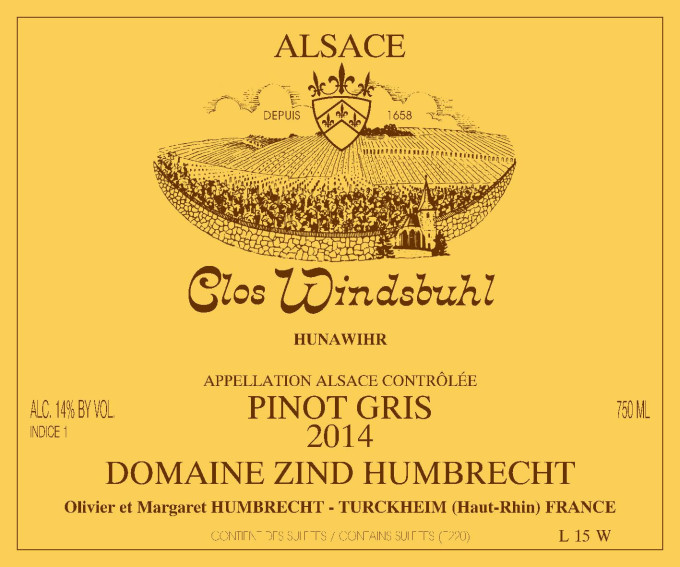
Technical presentation
| Bottling : | August 2015 |
|---|---|
| Acquired alcohol : | 14° |
| Residual sugar : | 7.0 g/l |
| Total acidity : | 3.9 g/l H2SO4 |
| pH : | 3.4 |
| Yield : | 22 hl/ha |
| Optimum tasting : | 2018-2034 |
| Average age of vines : | 45 years |
| Grape variety : | Pinot Gris |
| Terroir : | Clos Windsbuhl |
| Sweetness index : | 1 |
| Soil : | Muschelkalk calcareous, South East facing, South facing |
Description of the wine Pinot Gris Clos Windsbuhl 2014
The history of the Windsbuhl estate goes back to the 15th century. After being an imperial property of the Habsburg of Austria, it became a property of the French king after 1648. Reference to Tokay (Pinot-Gris) in the Windsbuhl goes back to 1760! There is an undoubtedly affiliation of the Pinot-Gris grape and this vineyard. The combination of later ripening climate and poor rocky limestone Muschelkalk allow the wines produced here to gain density and character but without losing elegance and structure. Noble rot can sometimes develop intensively but this wasn’t a good option in 2014. The wine fermented slowly but with great energy and kept little sweetness.

Tasting notes
02/2016 : Bright gold colour. The nose is probably still not expressing the whole potential of this wine and lots of time will be needed to allow it to open up. However, the smoky complex, wet stone, spicy, herbal notes give a wonderful sensation of complexity and are very promising. The palate is serious in the sense that there is no unnecessary sweetness to make it look easier. Rich and intense dry finish, enhanced by a beautiful salivating and ripe acidity. Clean, profound and pure, with almost a tactile dimension, this wine shows the best of the Windsbuhl. A class above any other Pinot-Gris made in 2014.

The Clos Windsbuhl of Hunawihr
The altitude of the vineyard coupled with Hunawihr’s tardy climate means that the Clos Windsbuhl is often one of the last of our vineyards to be harvested. This explains the aromatic quality of the Clos’ wines and the consistent balance of acidity, a guarantee of good ageing. Although often harvested late, the Windsbuhl grapes are only rarely botryitized, doubtless due to the altitude of the vineyard, but nevertheless often reach high levels of maturity.